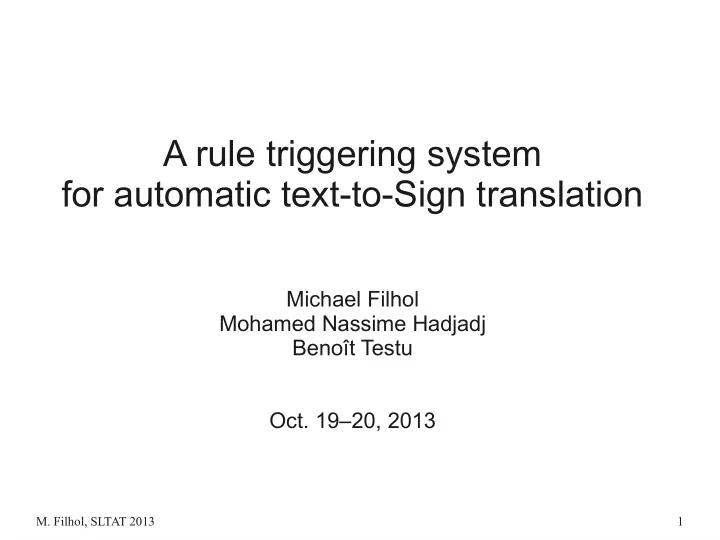

A rule triggering system for automatic text-to-Sign translation Michael Filhol Mohamed Nassime Hadjadj Benoît Testu Oct. 19–20, 2013 M. Filhol, SLTAT 2013 1
System architecture the cloud Avatar Synthesis (Kazoo) Translation system Input AZee model 3d SL text of SL message output M. Filhol, SLTAT 2013 2
Machine translation: an original rule triggering architecture ● Not a data-driven machine learning technique – Lack of corpus – What is aligned/learned? → linearity constraint ● Rule-based, but: – "backward" translation design – not a pipeline – built around a SL-specific description model M. Filhol, SLTAT 2013 3
Talk outline PART II – NLP PART I – Linguistics PART III the cloud Avatar Synthesis (Kazoo) Translation system Input AZee model 3d SL text of SL message output M. Filhol, SLTAT 2013 4
Sign Language ● Sign Language: – Many articulators, synchronisation issues – Depiction, iconicity ● The Azalee description model for synthesis: – All articulators (no preference) – Multi-linear synchronisation – Geometric specification of articulation – No level separation; all levels ● AZops: generic (context-sensitive) rule capability M. Filhol, SLTAT 2013 5
Rule specification ● Example: "place an object in the signing space" – depends on: the object , the loc ation, the class ifier time – generates: eyegaze target = loc object hold w-h if class is 1-handed class ballistic class at loc above loc dwn mvt ● Specify invariants in form for identified functions – form = observable production feature – function = interpretation of form feature sets ● Production rule : – The identified function is the rule header – The context sensitiveness is captured by typed rule dependencies – The systematic form is the rule body (invariant or function of deps) M. Filhol, SLTAT 2013 6
Methodology Corpus hunt for invariant links between forms and functions ● what to start with? – when to stop? – modality role shift marking eye gaze target manual gestures semantic segmentation shoulder line rotation features spatial eyebrow movements reference cheek puffs Function Form Historic example (cf. DictaSign wiki): ● 1. Form hunt: numbering buoys. → all enumerations 2. Function hunt: enumerations. → drop buoy criteria, many with fwd head mvt 3. Form hunt: forward head mvt. → all open lists of items 4. Function hunt: open lists. → systematic sync of fwd head on items. M. Filhol, SLTAT 2013 7
Working hypotheses (1) ● Rules have the potential for recursion (nestable rules) ● Rules together form a production grammar for a given SL TimeSpaceContext { date: RelativePast { duration: YearCount { n: 30} } place: QuantifMuch { sig: FAR } "Thirty years ago, in a event: ClassPred { country far away, a landmark: InvLat { sig: TREE { loc: $tree_loc } } rabbit came close to agent: RABBIT a tree." mvt: StraightMovement { side: S cfg: class_animal start: $tree_loc + medium LAT end: $tree_loc + tiny LAT } } } M. Filhol, SLTAT 2013 8
The rabbit and the tree TimeSpaceCtxt date: place: event: RelativePast QuantifMuch ClassPred duration: agent: sig: landmark: mvt: YearCount FAR InvLat RABBIT StraightMovement n: sig: 30 TREE side: cfg: start: end: S class_animal ... ... loc: $tree_loc Example: "Thirty years ago, in a country far away, a rabbit came close to a tree."
Recent rule search Corpus used : ● 40 chosen news items – 3 translators for each, in daily config. – 2 synchronised views with parallel text – ~1h LSF video – Elicitation prepared for a balanced mix of: ● event/date precedence, e.g. "E1 two days after E2" – event duration – event repetition – causal relationships between events – Recent study focused on event precedence and duration ● resulted in a consistent 6-rule system – in all cases: 15-day threshold for duration (of separation or of event) – WARNING: all chronological productions are linked to enunciation time, and in the past ● M. Filhol, SLTAT 2013 10
Resulting rules ● r1: separation of two events or dates by a period under 10 days ● r2: chronological sequence ● r3: period of at least 10 days ● r4: an event lasts for a period of more than 10 days' time ● r5: event lasts less than 10 days ● r6: dated/time-stamped event ● Example clips M. Filhol, SLTAT 2013 11
Working hypotheses (2) ● For translation , rules can be triggered by recognition of their function on the source language side ● One trigger module for each rule trigger object placement! " … There was a little kitten near the table watching the fish go round the bowl. Three feet away, a man yelled for more bear. … " M. Filhol, SLTAT 2013 12
Rule triggering system Text AZee input rules (ordered) (unordered) • TreeTagger • open lists • XIP • r1–5 • wmatch durations • enumeration tagger M. Filhol, SLTAT 2013 13
Example NLP modules ● Preprocessing – TreeTagger , XIP → classic – enum eration detection → based on punctuation and syntactic comparisons, useful for "open" and other lists – wmatch-timer → local semantic graphs for duration and date patterns – time seq graph → event ordering ● Triggering – open list : enumeration with "such as" header, non-counted plural before leading colon, ending in "etc." – r1 : patterns like <duration> + "après/avant" + subordinate clause – ... M. Filhol, SLTAT 2013 14
Problems to come ● "The cloud": how to combine output of different triggers? → PhD to come next year ● Evaluation: will BLEU or WER help? → multi-linearity issue ● Prospect for now: translator assistant software → cf. SL wiki M. Filhol, SLTAT 2013 15
Situation w.r.t. to Vauquois's triangle AZee rules are the most abstract elements → top corner, to the right! ● Target side: nothing to do but apply the rules (no layered scheme here) – Source side: an information extraction task for each rule (classical NLP) – ● Cf. " translators work into their language " ● A multi-level ascending transfer? M. Filhol, SLTAT 2013 16
Recommend
More recommend